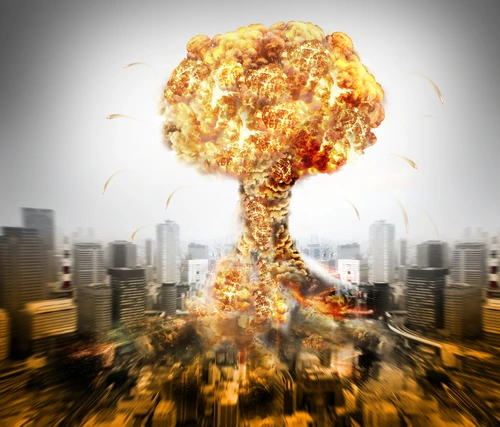
In 1984, the BBC broadcast Threads, a documentary-style drama in which a young Yorkshire couple rush to get married because of an unplanned pregnancy, but never quite get round to it because halfway through the film the Soviets drop a nuclear bomb on Sheffield. Jimmy, we assume, is killed in the blast (he just disappears, never to be seen again); Ruth survives, but dies of old age ten years later, while still in her early 30s, leaving her daughter to fend for herself in a post-apocalyptic wasteland.

It’s horrifying. It’s so horrifying I’ve never seen the whole thing, even though it’s an incredibly good film that is usually freely available online, because I once watched the ten minutes from the middle that show the bomb actually going off and it genuinely gave me nightmares for a month.
In my mind, I suppose, I’d always imagined that being nuked would be a reasonably clean way to go – a bright light, a rushing noise and then whatever happened next wasn’t your problem. Threads taught me that maybe I had a rose-tinted view of the nuclear holocaust.
Anyway. In the event you’d like to check what a nuke would do to the real Sheffield, the helpful NukeMap website has the answer.
What would a nuclear detonation do?
It shows that dropping a bomb of the same size as the one the US used on Hiroshima in 1945 – a relative diddly 15kt – would probably kill around 76,500 people:
 Those within the central yellow and red circles would be likely to die instantly, due to fireball or air pressure. In the green circle, the radiation would kill at least half the population over a period of hours, days or weeks. In the grey, the thing most likely to kill you would be the collapse of your house, thanks to the air blast, while those in the outer, orange circle would most likely get away with third-degree burns.
Those within the central yellow and red circles would be likely to die instantly, due to fireball or air pressure. In the green circle, the radiation would kill at least half the population over a period of hours, days or weeks. In the grey, the thing most likely to kill you would be the collapse of your house, thanks to the air blast, while those in the outer, orange circle would most likely get away with third-degree burns.
 Other than that, it’d be quite a nice day.
Other than that, it’d be quite a nice day.
“Little boy”, the bomb dropped on Hiroshima, was tiny, by the standards of the bombs out there in the world today, of course – but don’t worry, because NukeMap lets you try bigger bombs on for size, too.
The largest bomb in the US arsenal at present is the B-83 which, weighing in at 1.2Mt, is about 80 times the size of Little Boy. Detonate that, and the map has to zoom out, quite a lot.
 That’s an estimated 303,000 dead, around a quarter of the population of south Yorkshire. Another 400,000 are injured.
That’s an estimated 303,000 dead, around a quarter of the population of south Yorkshire. Another 400,000 are injured.
The biggest bomb of all in this fictional arsenal is the USSR’s 100Mt Tsar Bomba, which was designed but never tested. (The smaller 50MT variety was tested in 1951.) Here’s what that would do:
 Around 1.5 million dead; 4.7 million injured.
Around 1.5 million dead; 4.7 million injured.
We don’t have to stick to Sheffield, of course.
London detonation
Near universal fatalities in zones 1 & 2. Widespread death as far as St Albans and Sevenoaks. Third-degree burns in Brighton and Milton Keynes. Over 5.9 million dead; another 6 million injured.
New York detonation
More than eight million dead; another 6.7 million injured. Fatalities are effectively universal in Lower Manhattan, Downtown Brooklyn, Williamsburg and Hoboken.
Tokyo detonation
Nearly 14m dead. Another 14.5m injured. By way of comparison, the estimated death toll of the Hiroshima bombing was somewhere between 90,000 and 146,000.
I’m going to stop there. But if you’re feeling morbid, you can drop a bomb of any size on any area of earth, just to see what happens.
[Read more: The cost of Europe’s summer of wildfires]






